- in Health , Weight-Loss by tony
- |
- 1 comments
What is body composition
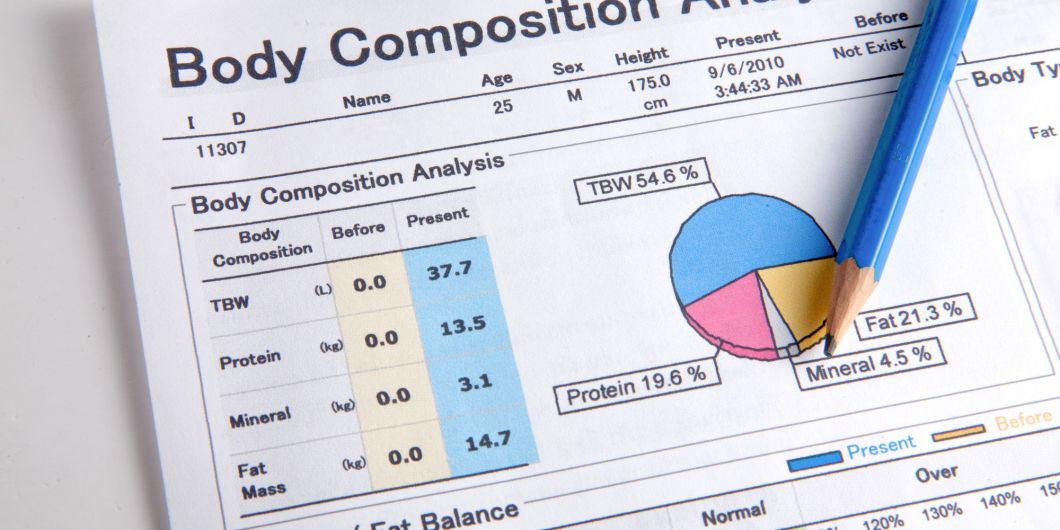
Your body is made up of mostly water. According to the four component model, a person's body breaks down into water, protein, minerals, and fat. Nobody can have zero percent body fat.
So why is all of this important?
It's important because there's more to your body than just losing or gaining weight.
More...
Jumping on to the scale, your weight is not just about your fat content. You must also consider your bones, your organs, your skeletal muscle, blood, and water – all combined – and they all vary from one person to the next.
Your skeletal muscle ranges between 30-50% of your total weight. Fat will probably be less than 10% if you are very lean but it can be as much as 50% if you are obese.
Your brain weighs in too at a couple of pounds and your bones will be about 15% of your body weight. Then there’s still your skin and your blood and so on and so on.
Your body composition is about the fat on your body and everything that isn’t fat.
Try to remember that fat can be your friend as well as your enemy and this is discussed more within another post.
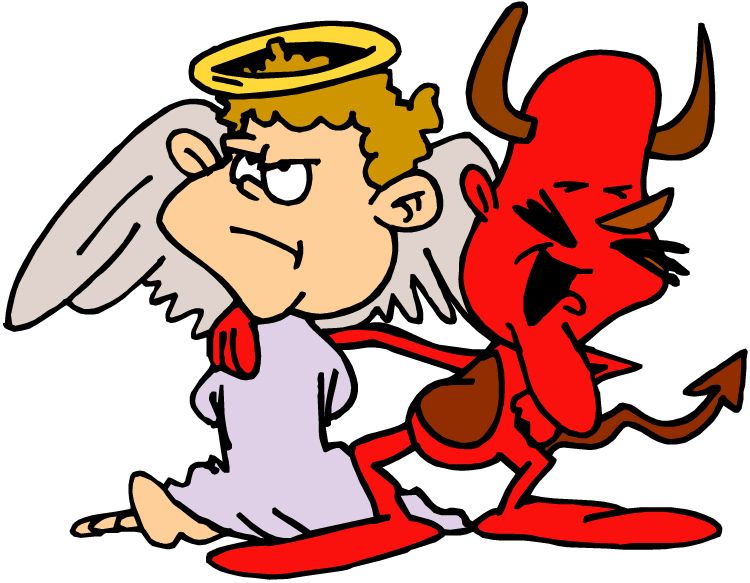
What isn’t fat is usually called FFM or fat-free mass.
If you lose weight but your FFM stays the same, it means you’ve lost fat, but not muscle. But if you were to restrict your calories, do a lot of cardio exercises and then eat a little bit of protein, you are going to lose weight, but it will be both fat and fat-free mass.
This is how people end up with kind of a skinny-fat body. When you do put on weight, generally the idea is to gain muscle, not fat. But anyway, you do have to gain a bit of fat if you want to get the best out of muscle growth.
However, if your fat mass is rising faster than your fat-free mass, it means you are eating too much.
For you to realize and know this, you must keep tabs on your body composition
There are great benefits that go along with improving your body composition and one of them is looking good – that is non-negotiable. But really, bottom line, it goes beyond that. When you start improving your body composition, you benefit big time, you kind of defy aging, you lose weight and you experience overall better health.
But how do you reach your target body composition – how do you bring yourself closer to those goals?
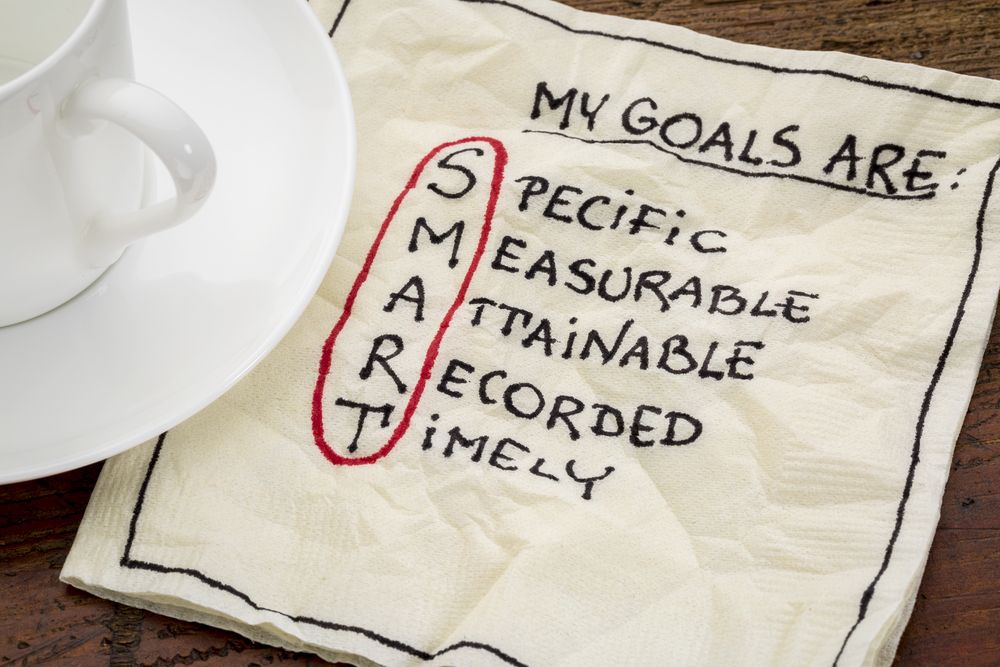
my goals are smart - goal setting
It’s not that difficult – it’s all about good nutrition and fitness. The benefits of improving your body composition go beyond looking good. Everybody has different dreams about their bodies.
Some want to look like incredible hunks while others yearn to look like the models you see in magazines –people with long, lean, toned, tanned bodies.
Men want a good chest, they want the abs, they want their back to be muscled and toned along with their shoulders. The women often want to make their abs and their hips their top priority.
Improving your physique is an excellent motivation, but you need to look past all the beautiful and aesthetic benefits that body composition brings and look at the bigger picture.
You need to think of your body as a wonderful machine – making sure that each screw, bolt, and component is in top working order and in top shape. Failing to keep every part of your body in shape will eventually catch up.
In fact, just five days of not using any of your muscles can lead to quite a substantial loss of your strength and skeletal muscle mass.
That might sound a bit extreme, but the risks of you leading a sedentary type lifestyle and neglecting your muscles are many.
Muscle neglect has become so neglected today that it’s created a whole new field of scientific research.
Why do you need to focus on setting body composition goals rather than just losing bodily weight?

People often wonder why there is so much talk about body composition goals when all you really have to do is to focus on just getting rid of some weight, right?
But no; because as we get older, our muscle and fat changes. Say for instance you want to rid yourself of 50 pounds of weight. But what if a quarter or half of that weight coming off ended up by you losing muscle mass?
If you hear anybody talking about going on a diet to lose weight, you can be sure that he or she are talking about losing body fat; not muscle mass.
Many don’t believe or even understand that whilst they are losing weight, they can lose muscle mass too. If your aim is to lose weight alone, you probably will end up looking thinner, but it won’t mean that you are healthier. Not only that, you probably won’t even have enough stamina and strength to endure on the mental and physical front either.
So, what must you do?
To be healthy and more physically and mentally fit, you need to start focusing on the long-term loss of fat from your body but building and maintaining lean muscle mass.
Looking at different somatotypes, or different body shapes.
How does your body type differ, such as how will different body types respond to diet and exercise and how can we work with your body type to effectively change or optimize your body composition.
By classifying different body types based upon their physique provides three generalized divisions of body types:
- endomorph
- mesomorph
- ectomorph
However, it’s rare for someone to fall entirely into one category. You might show qualities of more than one group, such as an ecto-endomorph or a endo-ectomorph.
While genetics do play a role in somatotype, external factors have an effect as well.
While you may be genetically predisposed to have a certain body type and structure, your lifestyle can also have an impact on your body composition and cause your somatotype to change.
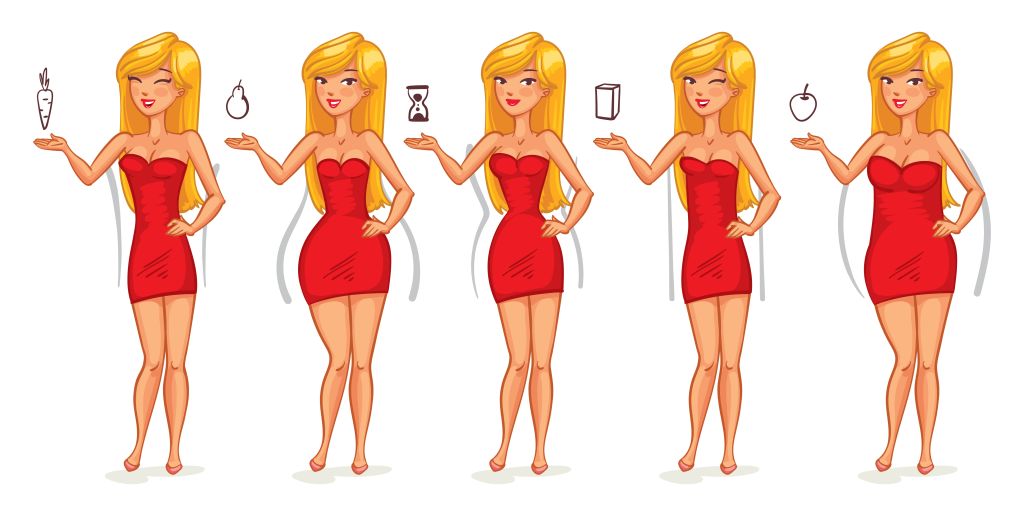

Ectomorphs (Thin) are naturally lean with a tendency towards long limbs, with little body fat, and little muscle.
They have a hard time gaining weight.
Fashion models and basketball players fit this category.
While most of us love to hate these genetically-blessed individuals, some male ectomorphs may not be thrilled with their narrow-chested frames, and some female ectomorphs long for more womanly curves.
Because they tend to be naturally lean with a tendency towards long limbs, ectomorphs typically possess that slender look no matter what type of diet they consume.
A lot of runners and swimmers are ectomorphs.
However, although they may have a decent amount of muscle, due to their long limb-length, they may appear visually to have lesser muscle development.
Endomorphs (Curvy) tend to struggle with their weight, gaining weight easily and losing weight with difficulty.
Female endomorphs are soft and curvaceous, and have a very feminine body shape. Males have soft and round bodies, but when in shape tend to look more like mesomorphs.
As an endomorph you may be described as ‘pear, spoon, triangle body type -shaped’. "Football lineman tend to be endomorphs -- they're heavier and rounder individuals, they don't have to necessarily be overweight but have difficulty losing weight.
Think gladiator Russell Crowe, Dwayne Johnson – “The Rock" and the beautiful actresses of the 1950’s. Both Oprah Winfrey and Marilyn Monroe are classic examples of endomorphs.
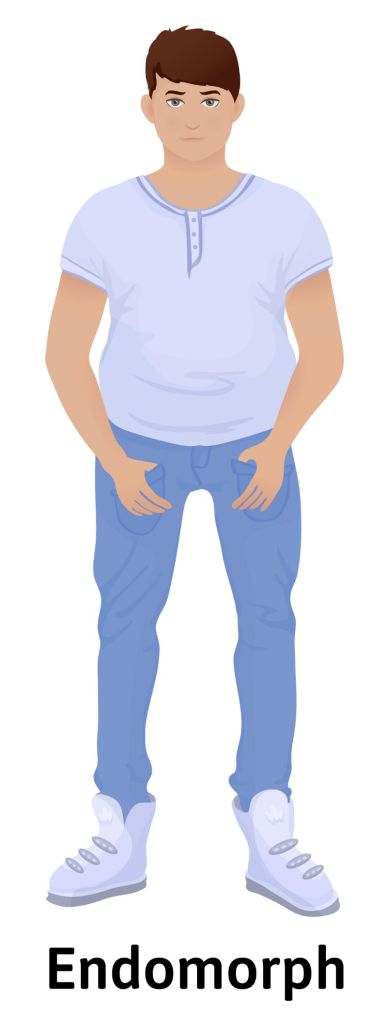
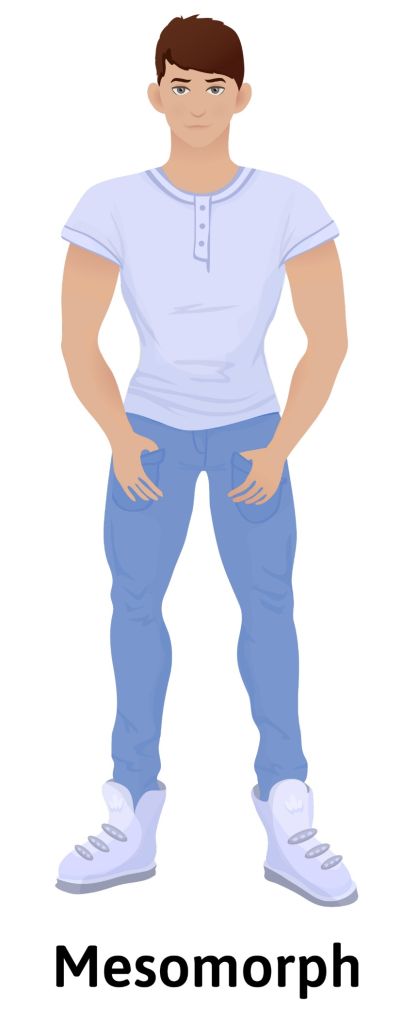
Mesomorphs (Muscular) are athletic, solid, and strong.
They're not overweight and not underweight, they can eat what they want without worrying too much about it.
They both gain and lose weight without too much effort.
As a mesomorph you will be muscular and well-built with an athletic body shape without having to live and sleep in the gym.
Your body type tends to find it very easy to build new muscle and you don’t store body fat like endomorphs.
Too often, people are presenting some mixed characteristics; they are a combination of the above three body types. It is rare to be one of the “pure breeds” I have described.
You need to analyze your physical and comportment characteristics, using the explanation of body types done above, to understand your precise body type.
Classic combination somatotypes include pear-shaped ecto-endomorphs with thin, delicate upper bodies and high fat storage in the hips and thighs.
Or, apple-shaped endo-ectomorphs, with high fat storage in the mid-section and thin lower bodies.
Reference: edu / Fitness
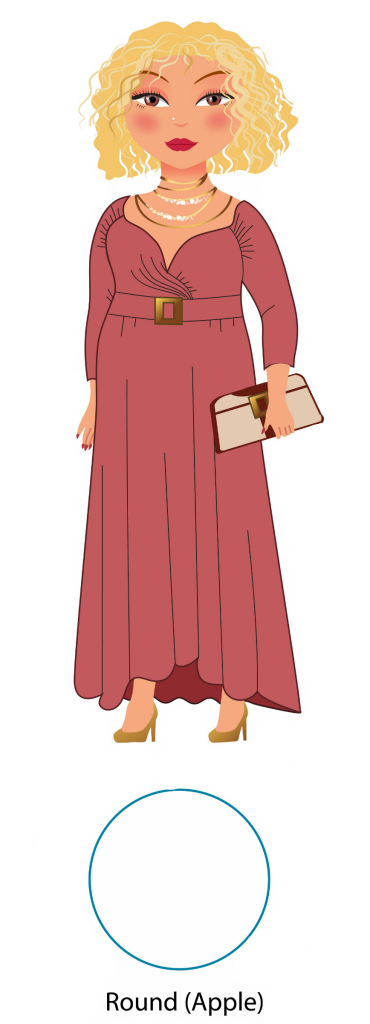
Obese men and women
Usually, women and men who fall into the category of obese are likely to have (Endomorphs) round body shapes characteristics. They will show excess fat in their entire body – you will notice it mostly in the abdomen area, the thighs, and the hips.
Men will show up with protruding bellies and for women, their hips and thighs are weighty.
To start losing the body fat, obese men and women need to straight away start consuming less processed foods; they need to reduce their calorie intake.
They can experiment with various diets and plans to partake in regular activities.
Obese adults can improve their body composition by doing the following:
- Reducing their daily calorie intake by around 500-1000 calories
- Consuming a low-fat, high protein diet
- Do aerobic training 3 to 5 times a week, plus resistance exercises 2 days a week.
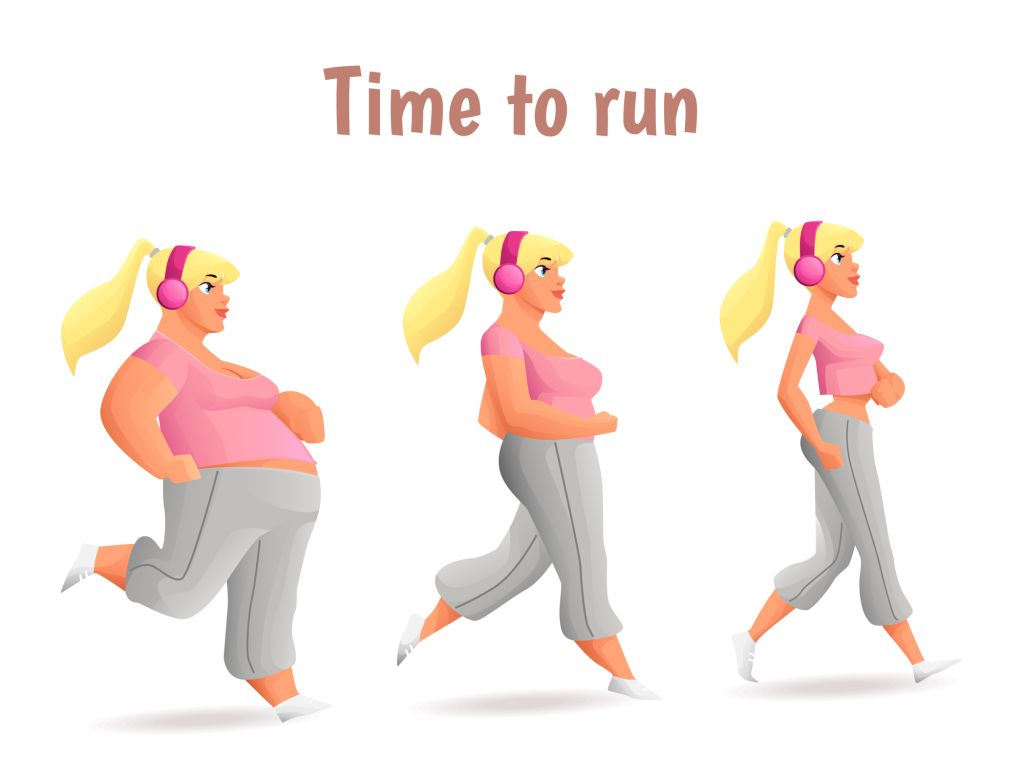
Overweight men and women
You can already start losing bone density by the time your 30's come around.
Not only that, you accelerate the process of losing bone density if your skeletal muscle mass is under-developed.
The health of your bones and your muscles are very tightly linked.
Research has discovered that people who have less muscle mass than the norm for their height; tend to have bones that are thinner and narrower.
This results in them having less bending strength.
As a result, they are at risk of falling with increased impaired balance.
Patients who have hip fractures appear to have a higher prevalence of muscle wasting and reduced leg muscle mass.
All the above complications above can have lifelong results.
It’s so serious that in another study it has been noted that women over 65 who have low muscle mass, 50% of them will never walk again.
Ouch!
If you are overweight, you need to follow the program in the ‘obese’ category.
Circuit training is very effective for improving body composition.
It means you gain muscle mass but lose fat at the same time.
Average fitness men and women
Women and men in this group will have some muscular definition, but they have a kind of softer look about them.
Off-season athletes usually are in this category.
These groups tend to have quite high energy levels and are in good health, even looking quite good in tight fitting clothes which help their self-esteem.
These people need to build habits that lean towards gaining lean body mass.
They need to focus more on eating less of the processed carbs and concentrating on higher protein intake after their resistance training sessions.


Athletic fitness men and women
Men and women in this category have good bodies, usually; beach body looks, being lean and muscular. You won’t be able to pinch much fat on them and they show muscles in their abs, arms, and shoulders.
Professional athletes are to be found in this category, particularly the athletes that move around a lot like the soccer players.
These kinds of people usually enjoy good health and usually, they stick to diets that work for them.
If these fitness people want to improve even more on their body composition, they could consider making use of fitness and nutrition coaches to keep within their body composition range consistently.
Exceptionally fit men and women
Men and woman in this category are usually bodybuilders or fitness models.
There is hardly any fat on their bodies.
Their diets usually consist of whole foods and they usually also have excellent energy levels.
This type of body composition, however, is difficult to maintain all the time and followers need to commit to their strict eating and exercise regimes.
Sometimes these people might even shun social gatherings so as not to eat and women can end up having fertility issues.

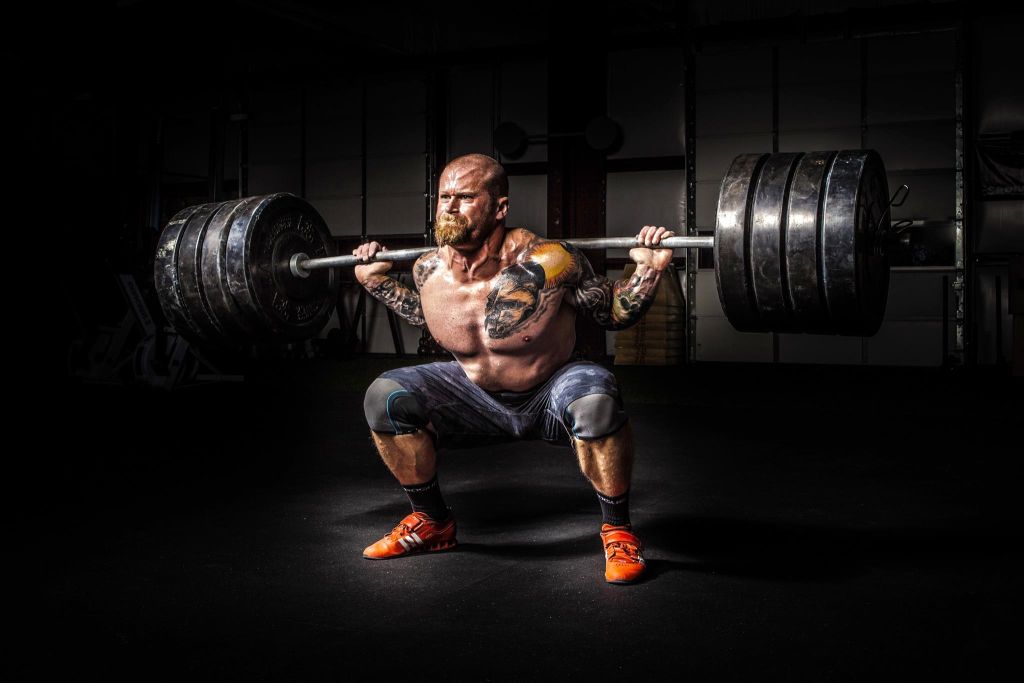
Anti-aging is all about muscles
- We have all heard how much good consuming antioxidants do for our health. They have been around for many years as being a vital part of anybody’s anti-aging plan.
- Look at carotenoids and flavonoids for example. Carotenoids and flavonoids have long been associated with the prevention of cancer and for reducing premature aging of the skin. Press the fast-forward buttons to today – new studies indicate that healthy and strong muscle mass is what is giving antioxidants a run for their money.
- Research reveals that decline in muscle mass – your strength – is not really a part of aging, so to speak, but more from the results of chronic diseases.
- Although people do lose muscle as they age, it’s not really because they are simply getting older, but because as they get older, they become more inactive.
- That’s the real culprit why people lose muscle loss. You can’t do much about aging, but you sure can do something about your inactivity.
- Look at post-menopausal women for instance. When they consistently participate in resistance training, they have increased muscle strength, improving by as much as 20% in a year.
- Researchers believe it’s because they have increased bone mineral density (BMD) which is responsible for defending them against brittle bones; another symptom of aging. The strength of your muscles can be greatly improved when you participate in resistance training.
- Physical aging can be slowed down when you involve yourself with physical exercises and activities regularly, particularly those exercises that keep your muscles from ‘believing’ they do not have a purpose anymore.
- You might be inquisitive about which exercises are required to get the benefits. To do that, let’s look at telomeres.
- These are the caps found at each DNA strand which protects our chromosomes – kind of like those little plastic tips you see at the end of your shoelaces. If those weren’t there the shoelaces would become all frayed and old looking, not really functioning properly at their best anymore. It is just so with telomeres.
- If telomeres weren’t there, the DNA strands would become damaged and your cells wouldn’t be able to do their job properly. When the telomeres are shortened, you age, period.
- Cells with shortened telomeres become unable to function and they secrete hormones that set the inflammation process going and the start of tumors. Telomere shortening is associated directly with aging. But like your muscle wastage, you can also do something about telomere shortening.
- People who do their exercises regularly end up with longer telomeres and we can all achieve these benefits. It is not necessary to spend your whole day sweating it out at the gym – just moderate exercise is effective. It’s more about keeping your muscles on the move, - maintaining muscle mass and your heart pumping – that’s the key.
- Not only will you be delaying shortening of your telomeres, but you will be maintaining muscle mass as you get older. You already lower your risk of insulin resistance and you lower your risk of death by 46% if you are over 65. Isn’t that good news?
- Many older people just rely on their cardio-based workouts like running. They leave out exercises that build and maintain their muscle mass. Of course, cardio has benefits, but bear in mind that the greatest benefits are often gained by going out of your comfort zone and strength training has no age limits. Doing strength training just twice a week is really all you need. Then as you get strong and your routine becomes less challenging, you can move to add some free weight training or some resistance training – you can do this at the gym or by purchasing kettle bells for example.
- You do not have to resign yourself to becoming slower and weaker as you get older. If you really want to know how to look and feel younger, then it’s time to rethink your relationship between you and your muscles.
Lean and mean muscles for golden years
Before working on your body composition, you need to know exactly where you are at. That will mean getting your self-tested. When you have the results in hand, you will be able to them the right goals for yourself and create the right habits that will help you achieve lasting body composition results to enjoy the process called Life.
Many of us assume that when we have little fat, we are healthy. But being thin does not reduce your health risk. When someone says you are thin, it means you weigh less than the recommended value for your weight and height.
However, being lean refers to your look which consists of your bone, muscle, and fat – the body composition of your body weight. Being lean intrinsically means you have greater muscle mass development than thin people.
A healthy body composition increases your lifespan; it reduces the risk of heart disease, cancer, diabetes, insulin resistance, and fantastic news – gives you greater energy levels as you age, improving your self-esteem.
You can expect early mortality with many diseases and if you have low body fat, you are prone to weak muscles, bone density loss, low testosterone levels, you are prone to be frail, to suffer from osteoporosis, to have no strength and be at higher risk of being hospitalized.
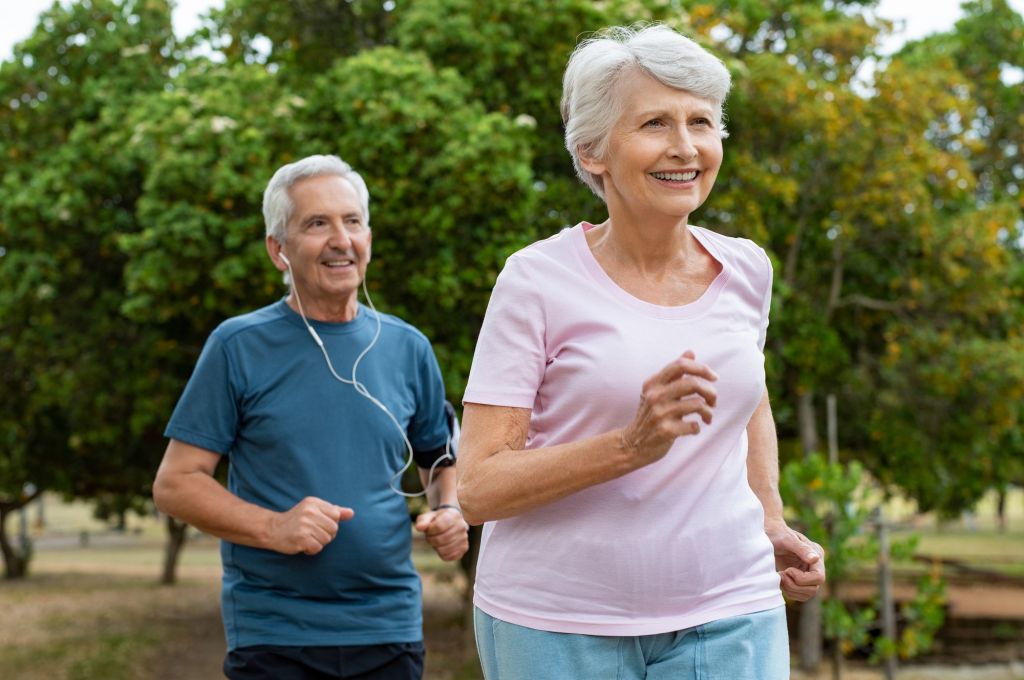
Get fit in the Gym…. Lose weight in the kitchen
Strengthen your muscles away from the gym as well:
For great body compositions and to strengthen your muscles, it is imperative also that you consume proper nutrition, otherwise what you do at the gym won’t really impact at all on your body composition.
Your bones require plenty of vitamin D and calcium, but your muscles need plenty of protein to keep them healthy and strong.
Women need about 46 grams of protein a day and mean about 56 grams of protein daily.
Around 10-35% of your calories need to come from protein daily if you want to stay lean.
Protein builds muscle and strong healthy muscle burns fat.
To sources of protein:
Lean meats: Stick to pork, chicken and the lean cuts of red meat.
Fish is an excellent source of protein, particularly salmon.
Not only are your muscles strengthened but your bones too.
Greek yogurt: Taking Greek Yogurt regularly gives you plenty of protein.
There are around 24 grams of protein in just one cup of plain Greek yogurt.
Keep the calories low by topping your yogurt with delicious fresh fruits and nuts for added flavoring.
Eggs: Breakfast isn’t really breakfasting without an egg!
Even though you are able to cut the calories by eating only the whites, the yolk is what has all the protein nutrients in.
Peanut butter and almond butter are healthy snacks that will keep you on the go, they have plenty of protein.
Don’t wish for it – work at it!
Aging is not about how old you are; it’s about how many years of fun and great health and strong bones and muscle you have experienced.
- How are your crow’s feet looking?
- Are your legs, upper arms, and belly flabby?
- When you take the take the stairs, are you gasping for breath?
You might have noticed that everybody who is getting older looks and feels this way.
There might well be limitations, but nevertheless, it is very possible to maintain and even to slow down a decline in your physical health into your autumn years.
What does it come down to then?
It is nothing more than improving on your body composition.
Allow your body to tap into this built in anti-aging system; that of your skeletal muscle mass – starting today.
According to the four component model, a person's body breaks down into water, protein, minerals, and fat.
The human body is made up of mostly water.
These four components are grouped into two categories fat mass and fat-free mass.
Nobody can have zero percent body fat.
So why is all of this important?
It's important because there's more to your body than just losing or gaining weight.
The InBody result sheet lets you know exactly what your body is made of using the four components by breaking down your weight, focusing on percent body fat, showing muscle development, and using body mass ratio (BMR) to help fine-tune your diet.
Let's take a look.
Break down your weight Muscle-Fat Analysis breaks down your weight into pounds of skeletal muscle mass and body fat mass.
Skeletal muscle mass is the muscle you can work out at the gym.
Body fat mass and skeletal muscle mass are the largest components of body weight and also important indicators for your health.
Focus on percent body fat Although commonly used, body mass index (BMI) is an unreliable representation of your health because it calculates your obesity level strictly on your height and weight resulting in muscular fit people being labeled as overweight or obese.
Instead, percent body fat, the ratio of your body fat mass divided by your weight, is a more accurate representation of your obesity risk.
See muscle development Segmental Lean Analysis reveals how lean your body mass is distributed within your body.
It also evaluates your right or left balance.
Use BMR to fine-tune your diet. Your BMR will increase as you gain more muscle mass. .
As found on Youtube
It can be really frustrating and disheartening to exercise a lot and eat really healthy and then step on the scale and see the number remain the same.
However, just because your body weight isn't changing, it doesn't mean your hard work isn't paying off. Especially if you are doing a lot of exercises, it's likely that your body composition has changed.
In this video, I'm looking at what body composition is and how you can improve yours.
While the scale will tell you how much you weigh, it doesn't tell you what your body's made of.
Body composition refers to everything in your body, split up into different compartments.
Now, two compartments are commonly used:
Fat mass and fat-free mass.
Now, fat mass refers to all the fat tissue in your body.
Fat-free mass is everything else, including muscle, organs, bone, and fluid.
Now, if both of them change at once, you might not see any changes in your body weight.
For example, if you start exercising, you may gain two pounds of muscle in the first month.
Now, at the same time, you may lose two pounds of fat due to burning more calories through exercise or changes in your diet.
Now, since your fat-free mass increased by the same amount as your fat mass decreased, your body weight won't change.
If you focus on the number on the scale, you may become discouraged or frustrated because your program, you know, doesn't seem to be working, even though it is.
This is just one example of why knowing your body composition is much more useful than strictly relying on body weight.
So, how can you assess it?
There are many methods to asses your body composition.
Some are really simple and easy to use and others are quite complicated.
One technique is tracking the circumference of different body parts.
You may have had your waist circumference measured with a flexible tape measure at the doctor's office.
At home, you can also track the circumference of other body parts, such as your hips, your arms, legs, or chest.
You can make these measurements using a cheap and flexible tape measure.
While a change in circumference can't tell you exactly if your fat mass or fat-free mass is changing, it can give you an idea. For example, decreases in waist circumference are typically a sign that you're losing belly fat.
Gram for gram, fat takes up more space than muscle.
This means your waist circumference may decrease when you lose fat, even if your weight doesn't change.
As another example, if you're exercising a lot with weights, an increase in arm circumference would usually indicate that your muscle mass is increasing.
The next option is taking progress pictures.
Now, it's often difficult to notice changes in your body from one day to the next but taking pictures of your body every few weeks or months, can be one way to assess how your body is changing.
Again, this doesn't give you exact information but it gives you a really good idea of how your body is changing in size and shape.
Lastly, there are also devices you can buy that measure body composition.
Many of these devices use a technology called bioelectrical impedance analysis, or BIA.
BIA sends small electrical currents through your body to see how much your body resists the current.
This information is used to predict your body fat percentage.
Now, while it is nice to see an actual number for your body fat percentage, many of these devices aren't terribly accurate.
In fact, research has shown that the common hand-held BIA unit underestimates body fat percentage by about eight to 10 percent compared to more accurate research tools.
What's more is factors food and water intake before using these devices can make the results inaccurate.
If you do use a BIA device, make sure you use it in the morning before you eat or drink anything and to make it a useful measurement
just make sure each time you do the measurement, you do it at the same time on the same day of the week.
So, if you do it on the first Monday of every month in the morning, keep that consistent.
And then you have a good measure of a baseline, before and after.
How to your improve your body composition with nutrition.
So your body composition is made up of fat mass and fat-free mass. Now, you can improve it by either reducing fat mass or increasing fat-free mass, which muscle, or both.
Any of these changes will lead to a decrease in your total body fat percentage, which is seen as the main number to describe your body composition.
Now, to change body composition a good place to start is with some basic principles of nutrition.
Now, although they aren't the only thing that matters, calories are one of the most important factors to consider. In simple terms, if you consistently eat more calories than your body uses, you will gain weight, typically as fat.
Likewise, if you consistently eat fewer calories than your body uses, you will lose weight.
After you consider how many calories you eat, think about how much protein and fiber are in your diet as well.
Protein is important for everyone but you may need more if you are active or trying to gain muscle or lose fat.
These are more satisfying than carbs or fat and your body also burns more calories processing protein than these other nutrients.
Fiber also has several health benefits and can increase the feelings of fullness and satisfaction after meals. It's really important for us to eat more fiber and it can be obtained from plant-based food sources, like fruits, vegetables, nuts, seeds, and legumes.
How to improve your body composition with physical activity and exercise.
Of course, physical activity and exercise are other crucial components for improving your body composition.
They not only increase the calories you use, but they are also necessary for optimal muscle growth. Since body composition can be improved by decreasing fat mass or increasing muscle mass, this is an important point.
It's recommended to choose forms of exercise that will also build muscle while you're losing fat.
Your muscles need to be challenged by exercise, particularly by weight training, to grow and get stronger.
So if you're engaging in this type of exercise, such as, you know, weight training, body pump classes, or even resistant weight training, then you need to be thinking about how can I assess and measure my body composition, not just body weight.
Ultimately, stepping on the scale is only gonna measure your weight. You can get a much more accurate and bigger picture by assessing body composition, or how much fat mass and muscle mass you have.
Thanks for watching, make sure to give this video a thumbs up if you found it informative and don't forget to subscribe to Healthline's Authority Nutrition Youtube Channel by clicking the red subscribe button below the video.
As found on Youtube
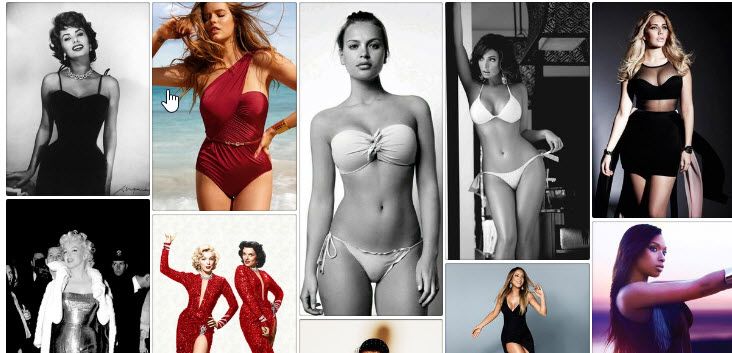
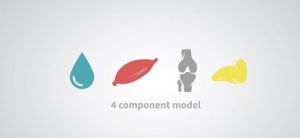
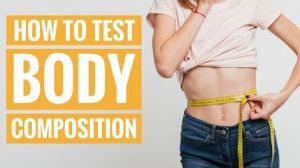










[…] an impact on your body shape and cause your physical appearance (silhouettes) to change over time. learn more about your body composition and […]